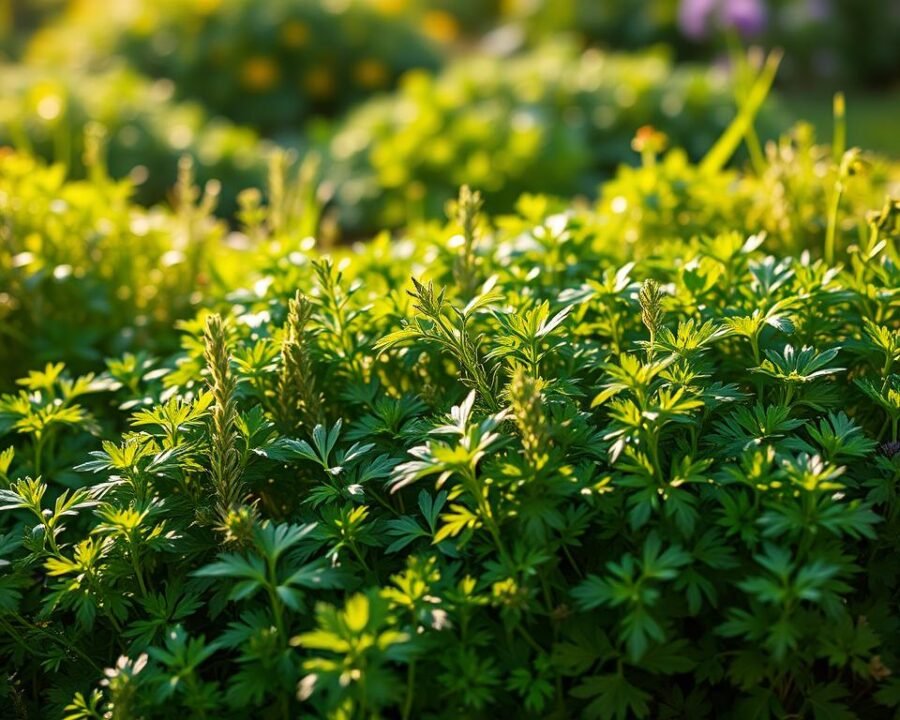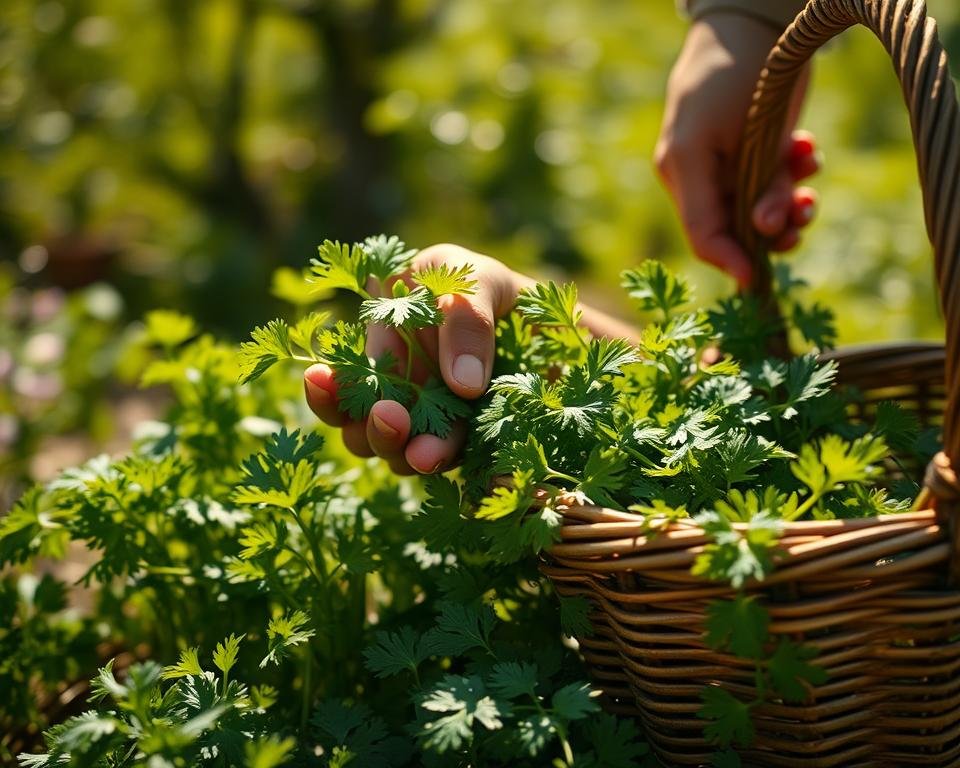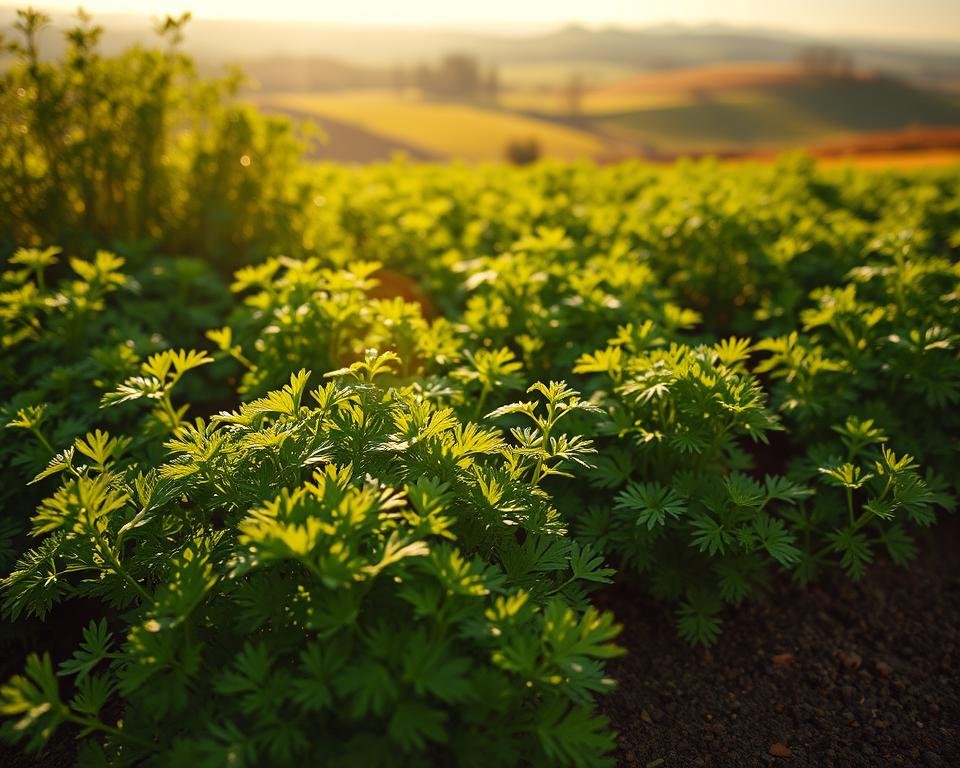Fresh, vibrant, and packed with flavor—parsley is a kitchen staple that elevates every dish. Whether sprinkled over roasted potatoes or blended into pesto, this versatile herb brings life to meals. Growing it at home ensures a steady supply of crisp, organic leaves right at your fingertips.
For those who love cooking or gardening, parsley is a must-have. It thrives in various conditions, making it perfect for beginners and experts alike. Beyond its culinary uses, it adds a lush, green touch to any space, doubling as a decorative plant.
In this guide, we explore top varieties suited for different climates. You’ll also find tips on growing, harvesting, and pairing it with other plants. Homegrown parsley saves money while offering unmatched freshness and nutrition.
Key Takeaways
- Parsley enhances dishes with fresh, bold flavor.
- Easy to grow in diverse environments.
- Works as both a culinary and decorative plant.
- Homegrown options reduce costs and boost health benefits.
- Includes growth and harvesting tips for success.
Why Parsley Deserves a Spot in Your Herb Garden
With its bright green leaves and fresh aroma, parsley brings a crisp touch to any meal. This humble herb does more than garnish plates—it’s a flavor powerhouse for sauces, pesto, and marinades. Its adaptability makes it a favorite for both novice and seasoned growers.
Deep Roots, Easy Growth
Parsley’s *carrot-like taproot* stretches up to 12 inches, thriving in loose, well-drained soil. For containers, choose deep pots to accommodate its roots. Raised beds work equally well, especially in compacted earth.
Just 4 hours of daily sun keeps this herb happy. It tolerates partial shade, making it ideal for balconies or shaded plots. Pro tip: Soak seeds overnight to speed up slow germination.
From Kitchen to Table
Fresh leaves elevate dishes year-round. In mild climates, harvest continuously by snipping outer stems. “A handful of chopped parsley transforms soups and salads,” says a home chef from California.
Whether blended into chimichurri or sprinkled over roasted veggies, parsley proves its versatility. Its hardy nature and culinary rewards make it a garden essential.
Top Parsley Varieties to Grow at Home
Parsley comes in several flavorful varieties, each with unique culinary and visual appeal. Whether you prioritize bold taste or eye-catching texture, there’s a type to match your needs. Below, we explore three standout options for home growers.
Flat-Leaf (Italian) Parsley: A Chef’s Favorite
Flat-leaf parsley boasts a robust flavor, making it ideal for cooking. Its smooth, dark green leaves blend seamlessly into sauces, soups, and marinades. Unlike curly types, it holds up well under heat.
*Pro tip*: Soak seeds for 24 hours before planting to speed up germination. This variety thrives in 12-inch containers or garden beds with well-drained soil.
Curly Parsley: Decorative and Mild-Flavored
With its ruffled leaves, curly parsley adds a pop of green to plates. Its milder taste suits garnishes, salads, and light dishes. Grow it alongside flowers for a striking contrast.
Seeds take 14–21 days to sprout. Keep soil moist but not soggy. Compact growth makes it perfect for small pots or window boxes.
Hamburg Parsley: Edible Roots and Leaves
This dual-purpose variety offers edible roots resembling parsnips and flavorful foliage. Roast the roots or chop the leaves for stews. It’s a rare find in stores but easy to grow at home.
- Planting: Requires deep soil (18-inch containers or raised beds).
- Harvest: Pull roots in late fall after frost sweetens their flavor.
Each type brings something special to the table—literally. Experiment to find your favorite!
How to Grow the Best Herb Garden Parsley You Need to Try
Getting started with this leafy green is simple with the right conditions. Whether in pots or garden beds, a few key steps ensure lush, flavorful growth. Let’s break down the essentials for thriving plants.

Ideal Soil and Sunlight Requirements
Parsley thrives in loose, well-draining soil with organic compost. A pH of 6.0–7.0 keeps roots healthy. For optimal results, mix in sand or perlite to improve drainage.
This plant loves full sun partial shade. Aim for 6–8 hours of sunlight daily. In hotter climates, afternoon shade prevents leaf scorch.
Container vs. Raised Bed Planting Tips
Containers should be at least 12 inches deep for root development. Ensure pots have drainage holes to avoid waterlogging. Raised beds work well for heavy clay soils, offering better aeration.
| Planting Method | Soil Depth | Moisture Retention |
|---|---|---|
| Containers | 12+ inches | Dries faster; water every 2–3 days |
| Raised Beds | 8–12 inches | Retains moisture longer; water weekly |
Watering and Fertilizing for Optimal Growth
Check soil moisture by sticking a finger 1 inch deep. Water when dry, aiming for consistent dampness—not soggy. Overwatering leads to root rot.
Feed plants every 3–4 weeks with diluted liquid fertilizer. For garden beds, use a 5-10-5 blend at 3 oz per 10-foot row. Organic compost enriches soil naturally.
“Mulching with grass clippings keeps roots cool and conserves water,” advises a Minnesota Extension horticulturist.
With these basics, your herbs grow vigorously, ready to enhance meals all season. Start small, observe, and adjust as needed.
Perfect Companion Herbs for Parsley
Pairing parsley with the right companions enhances growth and flavor. Some plants share similar soil and sunlight needs, creating harmonious groupings. Others, like mint, can overwhelm their neighbors. Below, we explore ideal partners and combinations to avoid.

Thyme and Oregano: Mediterranean Pairings
These drought-tolerant herbs thrive in well-drained soil, just like parsley. Oregano and thyme add depth to dishes while attracting pollinators with their flowers. Space them 10–12 inches apart to prevent overcrowding.
Pro tip: Group them in a sunny corner for a low-maintenance Mediterranean theme. Their shallow roots won’t compete with parsley’s deeper system.
Basil and Chives: Flavorful Kitchen Allies
Basil and chives complement parsley in both the garden and kitchen. Basil’s broad leaves shade soil, retaining moisture, while chives deter pests. Plant them in a pot or raised bed for easy access while cooking.
| Herb | Spacing from Parsley | Best Use |
|---|---|---|
| Basil | 8–10 inches | Pesto, salads |
| Chives | 6–8 inches | Garnishes, dips |
Avoiding Incompatible Herbs
Mint’s aggressive roots can choke nearby plants, including parsley. Always grow mint in separate containers. Fennel also stunts parsley’s growth—keep them at opposite ends of the garden.
- Mint: Confine to pots with drainage holes.
- Fennel: Plant at least 3 feet away.
“Companion planting reduces pests and boosts yields naturally.”
Harvesting and Using Your Parsley
Once your plants reach 6-8 inches tall, it’s time to enjoy the fruits of your labor. Proper techniques ensure continuous growth while maximizing flavor. Let’s explore how to pick, preserve, and incorporate this versatile herb into everyday meals.

Smart Harvesting for Continuous Growth
Begin harvesting when stems have three segments of leaves. Use clean scissors to cut stems near the base, leaving inner growth intact. This method encourages new sprouts while maintaining plant health.
- Start with outer stems first
- Never remove more than 1/3 of the plant at once
- Morning harvests yield the crispest leaves
For year-round supply, continuous sowing every 3-4 weeks works wonders. Stems regrow quickly when harvested properly.
Fresh vs. Dried: Flavor Face-Off
Fresh parsley packs a brighter, more complex taste. Its vibrant green leaves add texture to salads and garnishes. Dried versions concentrate the flavor but lose some nuance.
| Form | Best Uses | Shelf Life |
|---|---|---|
| Fresh | Garnishes, pesto, chimichurri | 1-2 weeks refrigerated |
| Dried | Soups, stews, spice blends | 6-12 months |
Creative Culinary Applications
Beyond garnishes, this herb shines in numerous dishes. Try these ideas:
- Blend into sauces like gremolata or salsa verde
- Mix with bulgur wheat for tabbouleh salads
- Infuse olive oil with stems and garlic
“Parsley stems contain intense flavor—perfect for stocks and broths.”
For preservation, freeze chopped leaves in ice cube trays with water or olive oil. Drying works well for long-term storage—hang bunches upside down in a dark, ventilated space.
Seasonal Care for Year-Round Parsley
Keeping parsley thriving through changing seasons requires simple adjustments. This hardy plant adapts well but benefits from tailored care during temperature extremes. With proper techniques, fresh leaves remain available regardless of weather conditions.
Spring and Summer Maintenance
Warmer months boost growth, demanding more frequent watering. Check soil moisture daily when temperatures exceed 75°F. Pro tip: Water early morning to prevent evaporation loss.
Provide 4-6 hours of morning sun with afternoon shade in hot climates. Feed every 3 weeks with balanced fertilizer. Pinch off flower buds to prolong leaf production.
- Prune yellowing stems weekly
- Apply 2-inch mulch to retain moisture
- Plant new seeds every 4 weeks for staggered harvests
Overwintering Tips for Colder Climates
Established plants survive mild winters with protection. Cover with fleece when frost threatens. In zones 5-6, construct simple cold frames using old windows and straw bales.
Reduce watering frequency as temperatures drop. Heavy mulching insulates roots—use shredded leaves or straw. Note: Second-year plants often bolt in spring; replant annually for best quality.
“Fleece-covered parsley often survives temperatures down to 20°F when properly acclimated.”
By adapting care each season, fresh parsley enhances meals all year. These methods ensure continuous harvests from summer salads to winter soups.
The Benefits of Growing Your Own Parsley
Cultivating fresh parsley offers rewards beyond just flavor. This resilient plant saves money, boosts health, and supports local ecosystems. Whether in garden beds or containers, homegrown varieties outperform store-bought options in freshness and sustainability.
Cost-Effective Alternative to Store Purchases
A $2 seed packet yields months of harvests, while grocery stores charge $3 per bunch. Over a year, growing your own can save $50+ for frequent users. Container-grown herbs require minimal space, making them apartment-friendly.
| Option | Initial Cost | Long-Term Value |
|---|---|---|
| Store-bought | $3/bunch | Weekly expense |
| Homegrown | $2/seeds | 6+ months of harvests |
Nutritional Powerhouse in Your Kitchen
Fresh parsley contains 150+ polyphenols and 574% daily vitamin K per ounce. These compounds support bone health and reduce inflammation. Compared to dried herbs, homegrown leaves retain more nutrients.
- Vitamin K: Essential for blood clotting
- Antioxidants: Combat cellular damage
- Folate: Supports heart health
“Fresh herbs like parsley deliver concentrated phytonutrients often lost during commercial processing.”
Ecological Advantages for Your Garden
When parsley flowers, it attracts pollinators like bees and butterflies. These beneficial insects improve yields for nearby plants. Unlike supermarket herbs, homegrown options eliminate plastic clamshell packaging.
Many gardeners report increased biodiversity within two seasons. The plants serve as host species for swallowtail butterfly larvae. This creates a vibrant micro-ecosystem right in your garden.
Conclusion
Nothing beats the aroma of freshly picked leaves in your kitchen. Whether it’s robust flat-leaf parsley, decorative curly types, or dual-purpose Hamburg, each variety brings unique flavors to meals.
Start small with containers—they’re easy to grow and perfect for beginners. The satisfaction of cooking with homegrown ingredients is unmatched.
Ready to expand? Pair your greens with thyme or basil using companion principles. Share your harvest photos and inspire others to join the journey!
